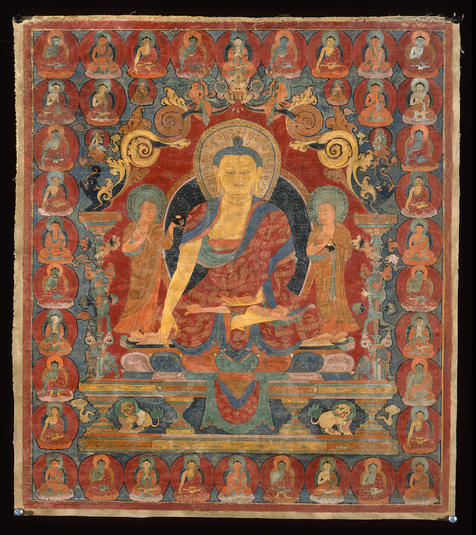
Item: Shakyamuni Buddha - with the 35 Buddhas of Confession
| Origin Location | Tibet |
|---|---|
| Date Range | 1400 - 1499 |
| Material | Ground Mineral Pigment on Cotton |
| Collection | Private |
Classification: Person
Appearance: Buddha
Gender: Male
Shakyamuni Buddha (Tibetan: sha kya tu pa, sang gye. English: the Enlightened One, Sage of the Shakya Clan) together with the two principal students, Shariputra and Maudgalyayana, standing at the sides while surrounded by the Thirty-five Confession Buddhas.
Sanskrit: Buddha Shakyamuni Tibetan: Sang gye sha kya tu pa
Tibetan: Sang gye sha kya tu pa
Just above the elaborate throne back, torana, are two very small images of Buddhist teachers. From the general appearance of the clothing they are likely to be Indian teachers rather than Tibetan. Slightly below those two figures and at the sides are White Tara and Green Tara. Between those pairs of figures are two Buddhas similar to the others depicted. These two Buddhas that appear to be out of order are most likely the Buddha of the past, Dipamkara, and the future Buddha Maitreya. Together with Shakyamuni Buddha at the center they represent the Buddhas of the Past, Present and Future.
In the outer register, top, two sides and bottom are thirty-four Buddha figures alternating in colour between white, red, blue, yellow and green. They also alternate between the five gestures of the Five Symbolic Buddhas. Those thirty-four Buddhas together with Shakyamuni Buddha at the center of the composition are the group known as the Thirty-five Confession Buddhas (excluding the two Buddhas - Dipamkara and Maitreya).
There are two basic divisions in the way that the Buddha figures are depicted iconographically - without hand attributes and with hand attributes. This composition, presumably the earlier system, depicts the Buddhas without having, or holding, any hand objects such as a vajra, sword, tree branch, etc. The Buddhas are simply shown with the hands in five basic and recognizable gestures.
This painting of the Thirty-five Confession Buddhas is the earliest composition currently on the HAR website.
Groups & Figures in the Composition:
- The Three: Shakyamuni, Shariputra & Maudgalyayana (numbers 1, 2, 3)
- The Three Buddhas of the Past, Present & Future (numbers 1, 2, 3)
- The Thirty-five Confession Buddhas (numbers 1 through 35)
- Two Unidentified Indian Monastic Teachers (blue, A & B)
- Two Tara: White & Green (blue, C & D)
Early examples of Tibetan torana, generally referred to literally as a 'throne-back' (Tibetan: gyab yol) appear purely artistic following the simple and varied models seen in India, Kashmir and Nepal. Side pillars were common and depictions of various kinds of birds and animals are found placed on the tops of the pillars. The actual arch can be formed as a stylized cave of multi-coloured rocks, an architectural form, or intricate vine work designs.
Depictions of early toranas showing an elephant on either side of a central figure with a sharabha above, and a makara above that, are found as early as the 12th century. Sometimes a boy is depicted atop the sharabha. Sometimes the makara is replaced by a goose. Again at other times a gurada - king of birds - is placed at the top center. There is a tremendous amount of variation. Some examples are very complex while others are very simple and plain in design.
In later Tibetan and Himalayan Buddhism, possibly developing in the 17th century, the ornately displayed throne-back, Torana, becomes known as the 'six ornament' design. The general shape is like an oval gate or frame, sometimes rectangular. On each side of the torana, at the bottom left and right are elephants. Supported above that are lions (or snow lions), a horse (often with the characteristics of other animals such as a lion, etc.). Above that is a small boy who sometimes holds a conch shell in one hand and supports a horizontal throne strut with the other. Above that is a makara (water creature). Above that is a naga - with a human upper torso and snake's tail for the bottom which extends upward. At the very top is a single garuda bird who bites down with the beak on the two extended tails of the two nagas from below, or bites down on a naga held in the outstretched arms. Sometimes there is an ornate silk canopy above the torana. It is not clear how the various elements of the torana are enumerated into the group of the 'six ornaments.' It is possible that the boy and the flying horse are grouped as one ornament. Regardless, the 'six ornament' design appears to be a late development of the torana in Tibet and is found primarily from the 17th century onwards.
Torana - Top Down:
Garuda
Nagas
Makaras (water monster)
Boys
Horses (sharabha, half lion)
Lions
Elephants
Symbolically the 'six ornaments' have many meanings such "as the seven things to be eliminated on the path, the six perfections, the four gathering things, the strength of the ten powers, the stainless and the clear light." (Gateway to the Temple by Thubten Legshay Gyatsho. 1971, 1979. page 46).
Jeff Watt 7-2011
Subject: Confession Buddhas without Attributes
Shakyamuni Buddha: Main Page
Collection: Private 1
Subject: Thirty-five Confession Buddhas Main Page
Subject: Torana, Shakyamuni Buddha (Early Animal Depictions)
Subject: Thirty-five Confession Buddhas Iconography
Tibet: Painting (West Tibet)
Subject: Confession Buddhas, 忏悔佛, ལྟུང་བཤགས་སངས་རྒྱས་སོ་ལྔ་། (Masterworks)
Painting Style: Guge Kingdom (Western Tibet)
Shakyamuni Buddha: Early Paintings




